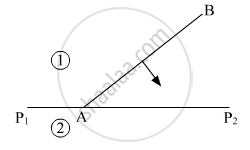Advertisements
Advertisements
Question
State Huygens’s principle. Show, with the help of a suitable diagram, how this principle is used to obtain the diffraction pattern by a single slit.
Draw a plot of intensity distribution and explain clearly why the secondary maxima becomes weaker with increasing order (n) of the secondary maxima.
Solution
Huygen’s principle states that
-
Each point on a wave front behaves as a source of secondary wavelets
-
The secondary wavelets travel with the speed of light in that medium
-
The position of new wave front at a later time can be found out by drawing a common tangent to all these secondary wavelets
Intensity distribution of single slit distribution

For the first secondary maxima (n = 1), only one-third of the slit contributes to its intensity.
Secondly, for n = 2, only one-fifth of the slit contributes to the intensity.
Therefore, with increasing n, the intensity decreases.
APPEARS IN
RELATED QUESTIONS
What is the shape of the wavefront in the following case?
Light emerging out of a convex lens when a point source is placed at its focus.
You have learnt in the text how Huygens’ principle leads to the laws of reflection and refraction. Use the same principle to deduce directly that a point object placed in front of a plane mirror produces a virtual image whose distance from the mirror is equal to the object distance from the mirror.
State Huygen's principle.
When the width of the slit is made double the original width, how would this affect the size and intensity of the central diffraction band?
Define the term 'wavefront of light'. A plane wavefront AB propagating from a denser medium (1) into a rarer medium (2) is incident of the surface P1P2 separating the two media as shown in fig.
Using Huygen's principle, draw the secondary wavelets and obtain the refracted wavefront in the diagram.

According to Huygen's construction, relation between old and new wavefront is ______.
The inverse square law of intensity is valid for a
What is the shape of the wavefront on earth for sunlight?
How is a wavefront different from a ray?
Represent diagrammatically how the incident planar wavefronts of wavelength λ pass through an aperture of size d, when d is approximately equal to λ.
